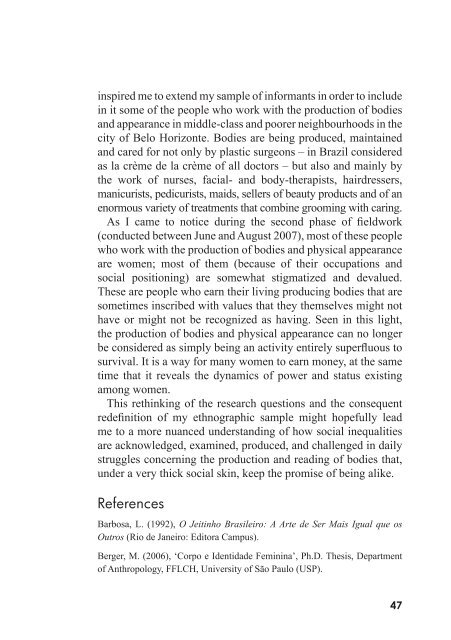Thinking with Bevereley Skeggs - Stockholms universitet
Thinking with Bevereley Skeggs - Stockholms universitet
Thinking with Bevereley Skeggs - Stockholms universitet
- No tags were found...
You also want an ePaper? Increase the reach of your titles
YUMPU automatically turns print PDFs into web optimized ePapers that Google loves.
inspired me to extend my sample of informants in order to includein it some of the people who work <strong>with</strong> the production of bodiesand appearance in middle-class and poorer neighbourhoods in thecity of Belo Horizonte. Bodies are being produced, maintainedand cared for not only by plastic surgeons – in Brazil consideredas la crème de la crème of all doctors – but also and mainly bythe work of nurses, facial- and body-therapists, hairdressers,manicurists, pedicurists, maids, sellers of beauty products and of anenormous variety of treatments that combine grooming <strong>with</strong> caring.As I came to notice during the second phase of fieldwork(conducted between June and August 2007), most of these peoplewho work <strong>with</strong> the production of bodies and physical appearanceare women; most of them (because of their occupations andsocial positioning) are somewhat stigmatized and devalued.These are people who earn their living producing bodies that aresometimes inscribed <strong>with</strong> values that they themselves might nothave or might not be recognized as having. Seen in this light,the production of bodies and physical appearance can no longerbe considered as simply being an activity entirely superfluous tosurvival. It is a way for many women to earn money, at the sametime that it reveals the dynamics of power and status existingamong women.This rethinking of the research questions and the consequentredefinition of my ethnographic sample might hopefully leadme to a more nuanced understanding of how social inequalitiesare acknowledged, examined, produced, and challenged in dailystruggles concerning the production and reading of bodies that,under a very thick social skin, keep the promise of being alike.ReferencesBarbosa, L. (1992), O Jeitinho Brasileiro: A Arte de Ser Mais Igual que osOutros (Rio de Janeiro: Editora Campus).Berger, M. (2006), ‘Corpo e Identidade Feminina’, Ph.D. Thesis, Departmentof Anthropology, FFLCH, University of São Paulo (USP).47
















